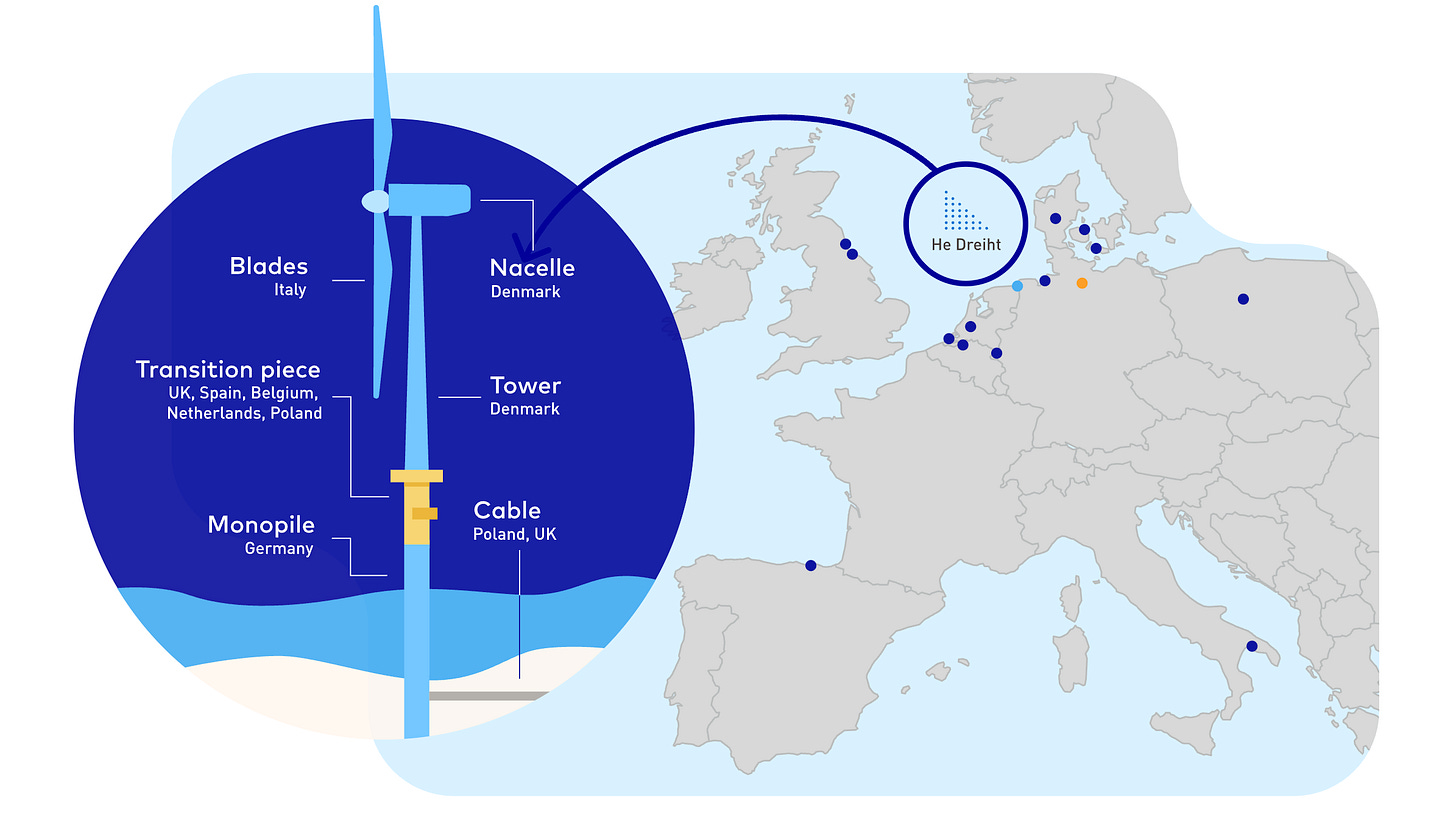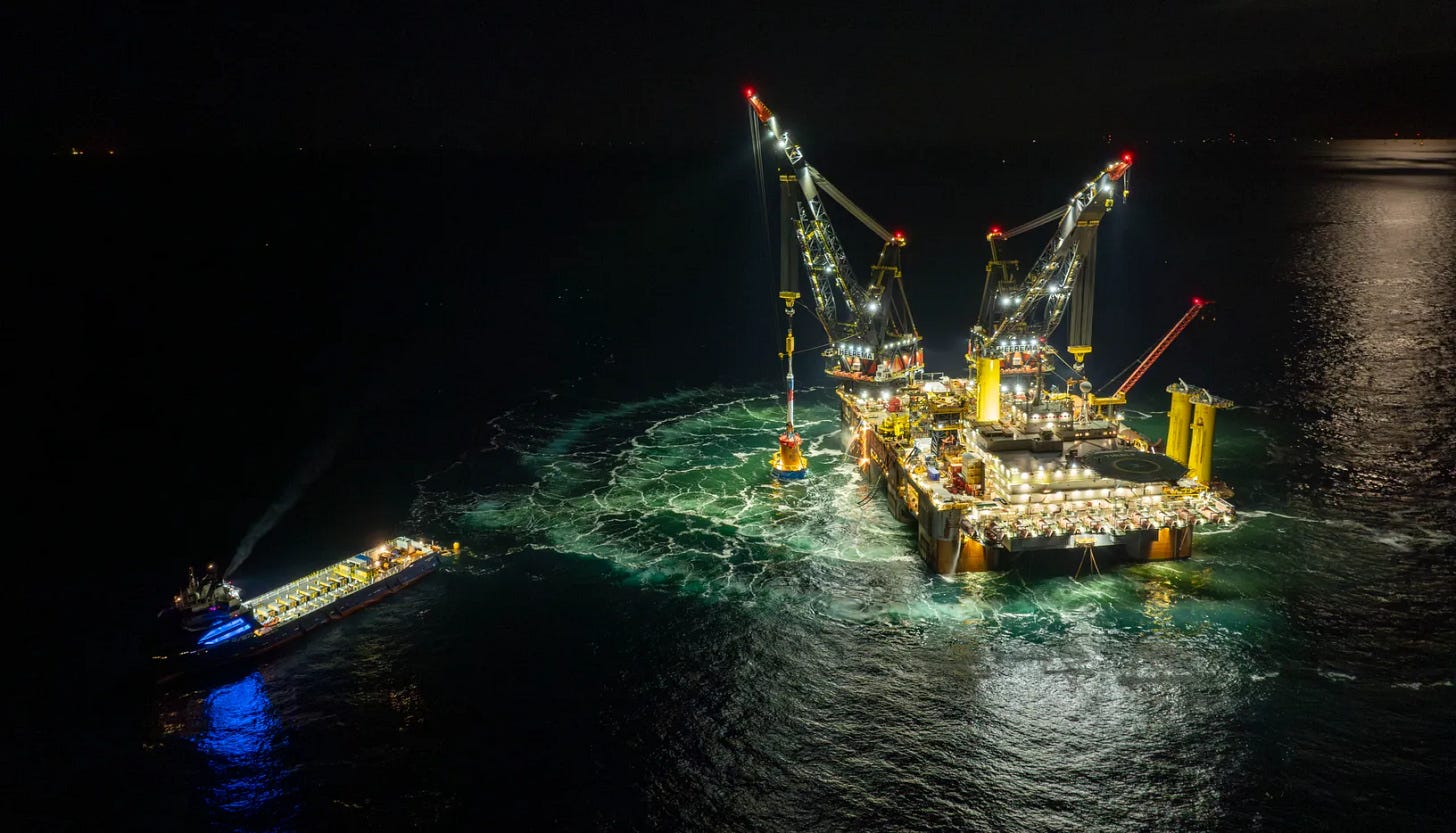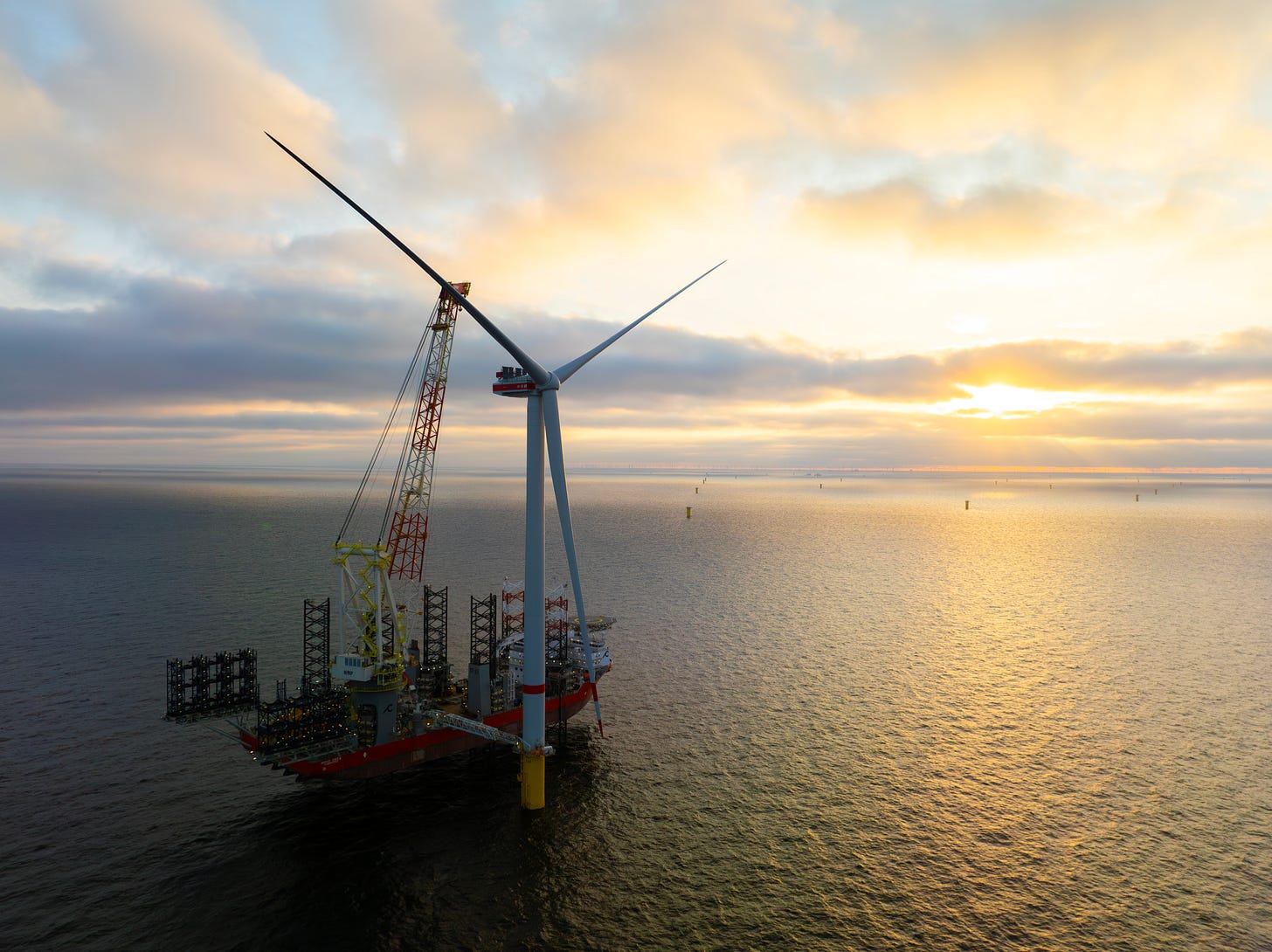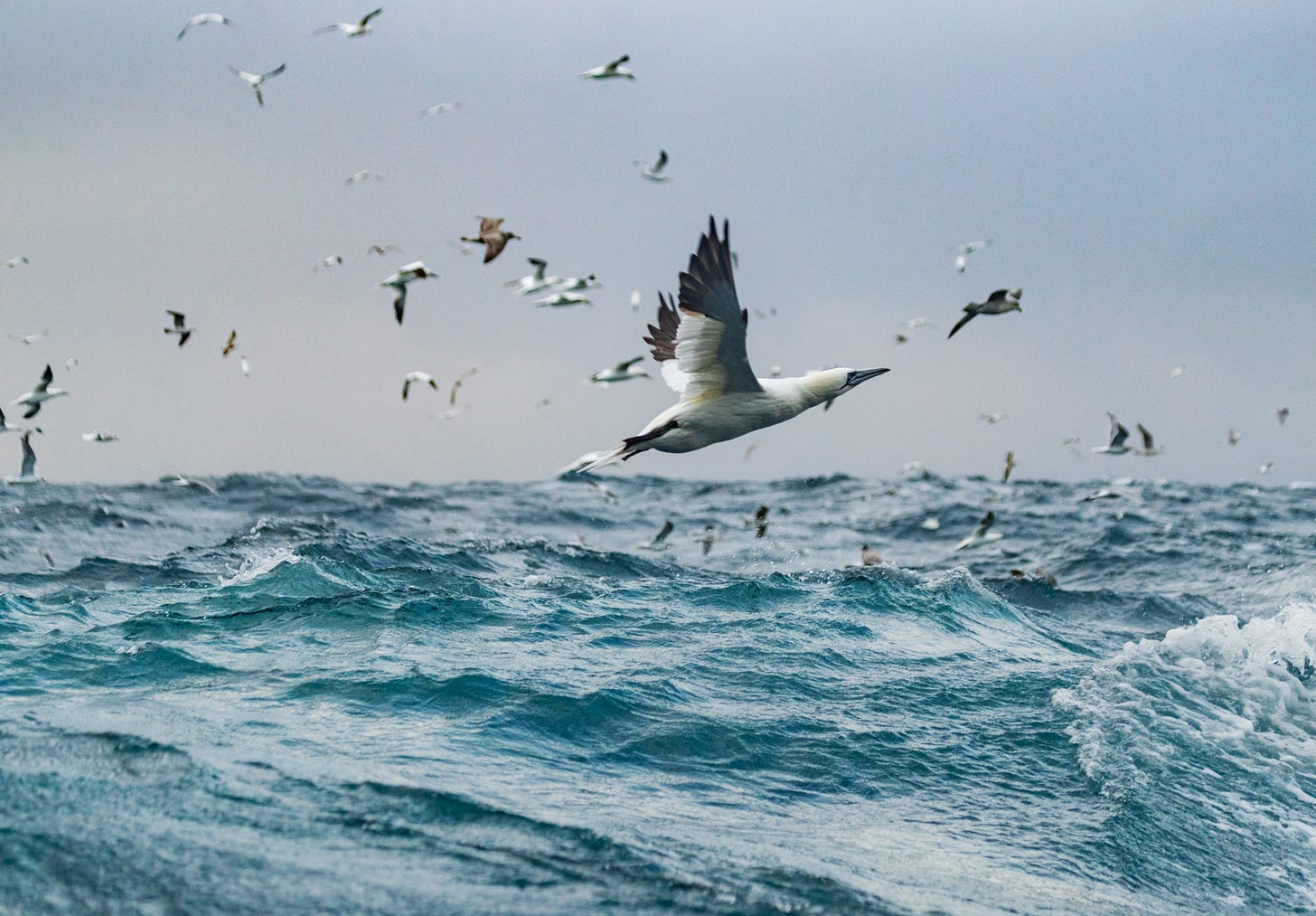He Dreiht set to spin in late 2025
Germany’s vast offshore wind project will reshape the local electricity sector — if they can avoid the gannets.
Welcome back to The Off Site, a newsletter by Aphex.
Germany is building its largest offshore wind farm using turbines that have never been deployed commercially before.
He dreiht is Low German for it spins, and its 64 Vestas V236-15MW turbines will certainly do that. Their swept area is equivalent to six football fields and, according to Vestas, a single turn of one turbine could power four households for a day.
Located off the northern coast of Germany, the €2.4 billion project requires some serious heavy lifting. It's also a test of whether offshore wind can work without state subsidies — a claim that operator EnBW is keen to prove.
It spins!
Located 110 kilometres west of the German archipelago of Helgoland, He Dreiht will be made up of 64 turbines planted in the middle of the North Sea. It’s an area known for choppy waters, screaming winter gales, and annual migrations of gannets and porpoises. It also has some of the world’s busiest shipping lanes and marine industry.
The driving force behind the project is German publicly-traded energy company, Energie Baden-Württemberg AG (EnBW). EnBW builds and maintains energy infrastructure that produces wind power, before selling it to various public and private companies.
They’ve already built two wind farms (Hohe See and Albatros) in a Special Economic Zone off the German coast. Because of this, He Dreiht will be able to make the most of existing infrastructure, including EnBW’s service station on the German mainland.
While the electricity produced by He Dreiht could power the equivalent of 1.1 million homes for a year, most of it has already been secured in power purchase agreements. For companies, it’s an excellent opportunity to work towards their zero-carbon targets. And for EnBW, it’s a key way to secure funding.
Who's building what
EnBW leads the project. They’ll retain 50.1% ownership after selling stakes to Norges Bank Investment Management, AIP Management, and Allianz Capital Partners.
Major contractors include:
Vestas Wind Systems, supplying all 64 turbines.
Steelwind Nordenham for monopile manufacture, with the Sif/Smulders consortium providing transition pieces to connect foundations to turbines.
Heerema Marine Contractors, who handled foundation installation using the Thialf crane vessel.
Seaway7, currently installing 100km of inter-array cables connecting the turbines.
TenneT (a Dutch-German grid operator), who will connect the farm to shore via the BorWin5 HVDC system – 120km of underwater cables plus 110km onshore.
Components arrive from multiple countries — turbines from Denmark's Esbjerg port, foundations from various European manufacturers, with project management and operations based in Hamburg and Emden.
Current progress and timeline
Construction began in May 2024 with foundation installation, which is now complete. And the first turbine was installed in April 2025.
In March 2025, Luxembourg’s Seaway7 fleet began installing the 100km of internal cabling that connects the 64 turbines. The project is currently navigating the challenge of coordinating turbine installation and cable work across the 60km² site.
The project aims for full operation by 2026, when it will generate 3.6 billion kWh annually.
‘Zero-subsidy’ financing
He Dreiht represents a significant shift in offshore wind financing: it's among the first German projects built without state subsidies.
Instead, EnBW secured long-term power purchase agreements (PPAs) with major industrial customers. These include 100MW to Deutsche Telekom, 85MW to Frankfurt Airport operator Fraport, 150MW to chemical company Evonik, and further contracts with Bosch, DHL, and Salzgitter steel.
A €600 million loan from the European Investment Bank helped fund construction, but the project's economics depend entirely on these commercial contracts rather than government support.
Installing the giants
As for the actual turbines, He Dreiht marks the commercial debut of the largest offshore turbine on the market — the Danish-built Vestas V236-15MW. (While New York’s Empire Wind hoped to be the first to use them, progress has been hobbled by a stop-work order).
These turbines stand 142 metres above the North Sea, and have a rotor diameter of 236 metres. Each turbine generates 15MW of energy, bringing the total installed output to 960MW.
To stand in those choppy waters, each turbine is attached to a 70-metre monopile. These monopiles weigh 1,350 tonnes each, and are driven into the seabed at depths of 37-40 metres.
Understandably, installing turbines and monopiles demands specialist vessels. Over 60 vessels and 500+ personnel were mobilised for the foundation installation phase alone.
First off the mark was the floating crane Thialf — one of the biggest boats in the world, which can accommodate 736 people and clocks in at 72,484 tonnes. Operated by Heerema Marine Contractors, Thialf helped maneuver the massive monopile pieces into place, as well as parts of the noise mitigation system.
Navigating the seabed
Unsurprisingly, the geological conditions of the North Sea site required carefully-planned interventions. Pre-installation surveys revealed mixed sand, silt, and clay layers with glacial till deposits, as well as boulders that needed to be removed before installation.
The seabed slopes gently (0.5-1.5°) but required micro-siting adjustments to avoid the risk of foundation subsidence. And, to handle different soil pressures, each monopile needed variable wall thickness (between 45 and 85mm).
Protection against the sea adds another layer of complexity. To protect against scouring, 500kg/m² rock armour surrounds each foundation. And cathodic protection systems protect the metal monopiles from North Sea salinity corrosion.
According to German environmental assessments, the monopile installation process also had to navigate around cold-water coral patches, with exclusion zones established to protect sensitive habitats identified during pre-construction sediment sampling.
The design also tries to account for the potential of more extreme weather as a result of the climate crisis. Seabed reinforcement takes into account 50-year storm surge projections, and turbine foundations include 15% extra capacity for changing wave patterns.
Managing environmental impact
German environmental regulations demanded extensive mitigation measures, particularly for marine mammals and seabirds.
Bubble curtains were deployed during pile driving, to reduce noise below the critical threshold for porpoise protection. Soft-start procedures allowed marine mammals time to leave the area before full piling began.
Between October-November and March-April, when the sky fills with migratory birds, the turbines are equipped with radar to trigger a temporary shutdown. And, to reduce the collision risk for northern gannets, the turbines are spaced 1.2 kilometres apart. To provide compensatory bird habitats, €8.7 million in funding has been invested into conservation on nearby Borkum Island.
Testing commercial viability
He Dreiht is more than the sum of its parts. The project requires executing complex offshore engineering, meeting strict environmental requirements and adhering to commercial timelines. EnBH’s project will also prove whether offshore wind technology has matured enough to work without subsidies.
Installation of the world's largest offshore turbines is a real-world test of whether this scale of technology can deliver reliable, cost-effective power, and whether the industry can rely on commercial contracts with energy-hungry industrial customers. If He Dreiht proves sustainable, the winds of change could be felt far abroad.
On the pod
This week on the pod, Jason and Carlos break down the confusing world of mega project delivery roles - from general contractors to delivery partners and managing contractors. They then discuss the rising trend of framework-style project delivery that's reshaping infrastructure. Finally, the pair analyse the on-again, off-again mega port project backed by China's Belt and Road Initiative.







https://rai1961.substack.com/p/the-uk-wind-turbine-scandal